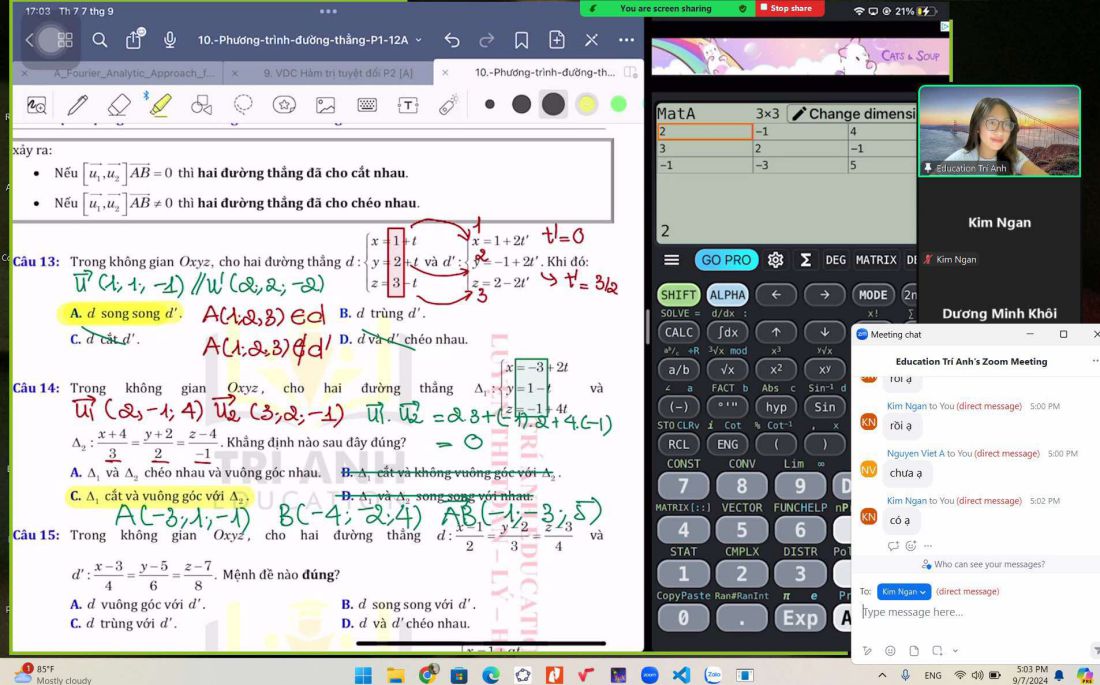Before each lesson, Ms. Thu An, a young teacher in Hanoi, sits down to review the lesson information on her iPad. For a long time, this tablet has become a tool closely associated with her lessons.
"The teaching and learning process requires teachers to be well prepared and have many operations and processes, specifically before, during, and after class, ensuring interaction between teachers and students, as well as teachers and parents. The above tools help my teaching process become more modern, updated, and more convenient. Previously, when the weather was too cold, or there were incidents, classes would often be canceled and postponed. But through the changes and transformations of education during and after the COVID-19 pandemic, many new forms of learning using technology have gradually become more popular and widely accepted," Ms. Thu An shared.
Change the interaction between teacher and student
Technology tools have gradually become familiar in classrooms in recent years. TVs, computers, and projectors have long been present in classes, helping both teachers and students in the process of transferring knowledge. Sharing with Lao Dong, Ms. Thu An said that technology tools can be divided into different groups, including presentation support devices such as projectors, laptops, iPads, recording microphones, or teaching support applications such as Zoom, GoodNotes. In addition, teachers often use learning material storage applications such as YouTube, OBS or interactive support applications such as Messenger, Zalo. With this support, students can even participate in online and in-person classes in the same lesson.
"In addition to teaching directly, I often teach via live stream. At that time, the class is expanded, many students living far away will also be able to study and connect with knowledge, there is no limit on the number of students who can attend a class, students can review the lecture. However, there are still limitations that teachers need to pay attention to when teaching via live stream.
When studying online, students' self-awareness and learning spirit will become a decisive factor in the effectiveness of that lesson. Although teachers can ask students to turn on their cameras, call students to interact and answer, students are often reluctant to turn on their cameras and microphones, and reasons such as broken computers become familiar answers in online classes. Not only that, teachers will not be able to observe the progress of their work in a timely manner, and it will be difficult to provide timely support because they are not directly next to the students," Ms. An added.

Technology is the new wind in education
Education is a field that is constantly changing to meet the needs of society and future generations. In the digital age, learning is no longer simply about books and chalkboards, but has become more diverse and flexible thanks to the emergence of advanced technologies. These improvements not only help students learn more effectively but also support teachers in imparting knowledge in a creative and lively way.
In addition to personal computers, interactive whiteboards are also widely used to create lively lectures. Thanks to the interactive feature, whiteboards help teachers engage students in lessons through multimedia elements, encouraging them to participate actively and be more interested in the learning content.
In addition, learning management platforms (LMS) have also become an important part of the modern education system. Platforms such as Google Classroom or Moodle help teachers organize and distribute assignments, track student progress, and reduce administrative workload. Not only that, LMS also acts as a bridge between teachers, students, and parents, making communication and feedback easy and effective.
In recent years, virtual reality (VR) technology has been used by many schools to provide immersive learning experiences. VR allows students to explore new environments and knowledge in a vivid way, from visiting historical sites, experiencing scientific phenomena to exploring the cultures of faraway countries. This is a unique way of learning, helping students not only absorb knowledge but also remember it longer thanks to visual experiences.
Adaptive learning platforms are also a prominent trend in education technology. These platforms use artificial intelligence to analyze students' learning styles and adjust content accordingly, helping each student have a unique learning path, optimizing learning efficiency. Adaptive learning tools help ensure that students are not left behind but always have the opportunity to progress according to their own abilities.
Not only at work, as a teacher of Generation Z, Ms. An also often uses technology applications to increase the ability to interact and connect with her students. According to her, a teacher - as well as a guide for young people, understands young people's psychology and can be a friend, a support for students to share their trust. Technology helps teachers stay updated with the trends, news and tendencies of young people, have common topics and "catch the frequency" of them.
"There was a time when I downloaded the Locket app to experience what it was, because I always saw students calling each other "Locket, guys", or using TikTok, there were simple dances and hand gestures that I could remember to film with the students. Technology also brought teachers and students closer together, creating more beautiful memories," said Ms. An.









